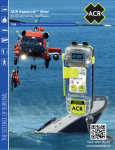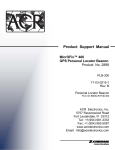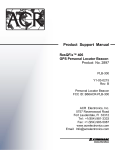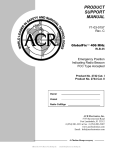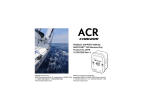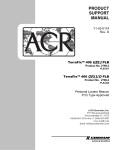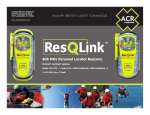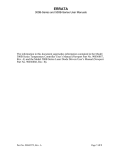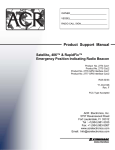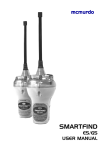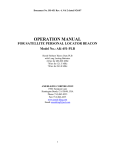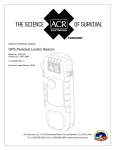Download ACR AquaLink™
Transcript
ACR AquaLink™ 406 MHz GPS Personal Locator Beacon PLB www.ACRARTEX.com ACR AquaLink™ 406 MHz GPS Personal Locator Beacon Head offshore with confidence. With three levels of integrated signal technology — GPS positioning, a powerful 406 MHz signal, and 121.5 MHz homing capability — the AquaLink™ quickly and accurately relays your position to a worldwide network of Search and Rescue satellites, reducing search time and increasing your chances of survival. It’s reliable signaling technology that has saved more than 30,000 lives since 1982. The AquaLink™ broadcasts a unique registered distress signal that not only tells rescuers where you are, but who you are. The onboard GPS can fix your position to within 100 meters and then utilizes a powerful 406 MHz signal to relay your distress call to orbiting satellites. As local Search and Rescue is deployed, a separate homing signal and integrated LED strobe light guide rescuers to your exact location. overboard. Performing a full functional self test of the PLB’s internal circuitry, battery voltage & power, and 406 MHz transmission gives you peace of mind knowing your PLB will work the moment you need it most. ACR Exclusive: Built-in GPS acquisition test mode allows you to test GPS functionality up to 12 times over the life of the battery. The AquaLink™ is small enough to be easily carried in a pack or pocket or can be worn on deck, at the helm, in quarters or on a life vest and will float if accidentally dropped Tap in to the same field-tested rescue technology used by the U.S. Military, U.S. Coast Guard, NATO Special Forces and Arctic explorers. SPECIFICATIONS Product Number 2882 Model Number PLB-350 B Size 2.3 x 5.8 x 1.45” (5.9 x 14.8 x 3.7 cm) Weight 9.2 oz (261 g) with lanyard Battery, Class Class 2 (non-hazmat) lithium batteries • No Subscription Fees • Floats Battery, Replacement Interval Replacement due six (6) years from date of manufacture or five (5) years after beacon is placed into service, whichever is first, or after emergency use • Super Bright LED Strobe • On Board 66 Channel GPS Battery, Operational Life Exceeds 24 Hours @ -4°F (-20°C) • Self-Test and GPS Test Features Battery, Typical Performance 35 Hours @ -4°F (-20°C) 5.8” Battery, Storage -40°F to + 158°F (-40°C to +70°C) Material Engineered polycarbonate blend Color ACR-treuse™ (high visibility yellow) Activation Manual Operation 2 steps: deploy antenna, press ON button. Give clear view of sky Waterproof 16.40 ft (5 m) @ 1 hr., 33 ft (10 m) @ 10 min. Factory tested @ 70°F, exceeds RTCM waterproof requirements • Typical Performance 35 Hours • Non-Hazmat Battery • Made in the U.S.A 2.3” 1.45” Radiated Power 6.3W (406 MHz), 50 mW +/-3dB (121.5 MHz) Accessories Attachment clip included Approvals Cospas-Sarsat, FCC, Canada, R&TTE Limited Warranty 5 years Lead Free Yes It is mandatory that you register your PLB. It’s fast, easy and free www.beaconregistration.noaa.gov. When activated, the unique identification code in your PLB is linked to the registration database. This way authorities can retrieve valuable information about you and your trip. The AquaLink™ is a satellite signaling device of last resort, for use when all other means of self rescue have been exhausted, where the situation is grave and imminent loss of life, limb, eyesight, or valuable property will occur without assistance. © 2012 ACR Electronics, Inc. 03/12 For further information please contact: ACR Electronics, Inc. 5757 Ravenswood Road Fort Lauderdale, FL 33312 Tel: (954) 981.3333 Fax: (954) 983.5087 Email: [email protected] www.ACRARTEX.com PRODUCT SUPPORT MANUAL PLB-350B 406 MHz Personal Locator Beacons Product No.: 2882 2883 (AquaLink™) (SARLink™) Y1-03-0241-2, Rev. F ACR Electronics, Inc. // 5757 Ravenswood Road // Fort Lauderdale // FL // 33312-6645 Tel: +1 (954) 981-3333 // Fax: +1 (954) 983-5087 // www.acrartex.com About ACR Electronics ACR Electronics www.acrartex.com, designs and manufactures a complete line of safety and survival products including EPIRBs, PLBs, AIS, SARTs, Strobe Lights, Life Jacket Lights, Search Lights and safety accessories. The quality systems of this facility have been registered by TUV to the AS9100C/ISO 9001:2008 Series Standards. Recognized as the world leader in safety and survival technologies, ACR has provided safety equipment to the aviation and marine industries as well as to the military since 1956. CAUTION: Before proceeding to install, test or use your new ACR Electronics’ product, please read this Product Support Manual in its entirety. If you have questions regarding the contents of the manual or something not covered in the manual, please contact our Technical Service Department at ACR Electronics, Inc., Telephone +1 (954) 981-3333. You can also visit our website at www.acrartex.com and access the Frequently Asked Questions (FAQs) section for further information. If in the future you lose this manual, you may access and print a replacement on the ACR website. PLEASE READ ALL WARNINGS, CAUTIONS AND NOTES CAREFULLY Y1-03-0241-2F 1 Table of Contents STEP ONE - REGISTERING YOUR BEACON _____________________ 3 STEP TWO - HOW THE BEACON WORKS ______________________ 5 STEP THREE - MAINTAINING YOUR PLB ______________________ 13 APPENDIX A - ACCESSORIES _______________________________ 17 APPENDIX B - THE COSPAS-SARSAT SYSTEM ___________________ 18 APPENDIX C - TECHNICAL SPECIFICATIONS ____________________ 19 APPENDIX D - WARRANTY, USEFUL LIFE POLICY, NOTICES ________ 20 APPENDIX E – RESTRICTIONS ON USE ________________________ 21 NOTE re: Applicable products This manual supports all configurations of PLB-350B beacons. In addition to the part numbers listed on the cover page, other configurations of these products may be available, thus you may have purchased a product configuration with a different version of the part number (for example, 2880.63). As long as the first four digits are the same as one of the part numbers on the cover, this manual is applicable. Y1-03-0241-2F 2 STEP ONE - REGISTERING YOUR BEACON Why is registration important? As the owner of this 406 MHz beacon, it is mandatory that you register it with the PLB national authority of your country: It is the law. Please note that all 406 MHz beacons are required to have their registration updated every two years by the owner. Your personalized ID code programmed inside each beacon is transmitted to Search and Rescue (SAR). SAR forces use this code to pull up your registration to find out valuable information about who needs help. YOUR RESCUE WILL BE DELAYED IF YOUR BEACON ISN’T PROPERLY REGISTERED! HOW REGISTRATION WORKS: All 406 MHz beacons transmit a Unique Identifier Number (UIN) when activated. The UIN is programmed based on the country in which the beacon's owner resides, thus authorities are able to determine which country’s database will have your registration information. SAR forces will have information as to who you are as the owner of the beacon, the name and type of vessel that you have (if applicable), your address, and who to contact that might know of your current situation - but only if your beacon has been properly registered. Valuable search and rescue resources are wasted every year responding to false alerts, and registering your beacon helps to resolve this quickly. Y1-03-0241-2F 3 What country should I register in? The beacon must be registered in the country of the owner’s residence. If the beacon is not programmed to that country’s code and protocol, and the residence is outside of the USA, the beacon needs to be reprogrammed. The beacon must be reprogrammed if you, as the owner, permanently move out of the country where the beacon is registered. To verify the country for which a beacon is programmed, see the label with the UIN (Unique Identification Number) on the back of the unit. How do I register? Registration in the United States The national authority that accepts registrations in the United States is the National Oceanic and Atmospheric Administration (NOAA). There are three ways to register: 1. The fastest and easiest way to register is online at www.beaconregistration.noaa.gov/. 2. Faxing a registration is also acceptable. Fax the registration form to the fax number on the top of the registration form. NOTE: Do not confuse the registration form with the ACR Electronics warranty card. 3. If online or fax registration is not available, mail the registration form with the pre-addressed, postage paid envelope to: SARSAT Beacon Registration NOAA NSOF, E/SPO53 1315 East West Hwy Silver Spring, MD 20910-9684 All registration forms will be entered in the 406 MHz beacon registration database within 48 hours of receipt. The information you provide on the registration form is used for rescue purposes only. A confirmation letter, a copy of the actual registration and a proof-ofregistration decal will be mailed to you within two weeks. When you receive these documents, please check the information carefully, and then affix the decal to your beacon in the area marked “BEACON DECAL HERE.” It is very important that the proof of registration decal matches the UIN on the beacon. If you do not receive confirmation back from NOAA within two weeks, call toll free (888) 2127283 for assistance. Y1-03-0241-2F 4 Registration in Canada Canadian residents can register online at: http://canadianbeaconregistry.forces.gc.ca/ or contact the Canadian Beacon Registry by phone at: 877-406-7671 or by fax at: 877-406-3298. Canadian Beacon Registry CFB Trenton, PO Box 1000 Stn Forces Astra, Ontario K0K 3W0 Registration in Other Countries In countries other than the United States and Canada, 406 MHz beacons are registered with that country’s national authority at the time of purchase. The sales agent may have assisted you in filling out the forms and sending them to the country’s national authority. Alternatively, many countries allow online registration in the International 406 MHz Beacon Registration Database (IBRD) at www.406registration.com. To verify that the unit is properly programmed for your country, view the UIN label on the back of the unit. In the event that the beacon is not programmed for your country, the sales agent (if properly equipped) can reprogram the unit for the correct country. STEP TWO - HOW THE BEACON WORKS NOTE: Please be aware that, throughout your user manual, reference is made to the beacon ‘BEEPING’. Please note that the ‘beeps’ are of a very high pitched tone that some people are unable to hear. Be aware that the beeps are not the indication of a fully functional beacon but only a guidance to Technicians and Engineers to troubleshoot the unit. 1. How your beacon brings help 406 MHz beacons are a type of portable emergency equipment that transmits a distress signal to search and rescue (SAR) organizations. The purpose of these beacons is to aid SAR teams in tracking and locating ships or individuals in jeopardy as rapidly as possible. The 406 MHz frequency is a worldwide dedicated emergency frequency that is detected by a network of satellites called the Cospas-Sarsat system. This satellite system was established by, and continues to be supported by, its primary benefactors - the USA, Russia, Canada and France. The Cospas-Sarsat system has saved over 28,400 lives - and counting - since its inception. See Appendix or the Cospas-Sarsat website for more information about the system at www.cospassarsat.org. When a 406 MHz beacon is activated, the digital distress message is sent to Cospas-Sarsat satellites and, in turn, the distress message is relayed to SAR. The distress message contains the beacon UIN and on Y1-03-0241-2F 5 some models the GPS location of the beacon. Additional information about the beacon is accessed by SAR from the beacon registration database. At the same time the 406 MHz signal is activated, a 121.5 MHz signal is turned on. The 121.5 MHz signal is used by SAR to home in on the beacon as they approach it. The 406 MHz signal is detected by multiple satellites and from that information the location of the beacon can be calculated. This data alone is sufficient for SAR to find persons or ships in distress in a reasonable timeframe. However, as a further enhancement, some beacons have a GPS engine onboard. This feature allows the beacon to acquire current location coordinates from an internal GPS receiver. The purpose of this feature is to send an even more precise location of the beacon to the satellites, i.e., latitude and longitude data. This helps SAR to reach the location even faster. 2. Internal GPS position system The PLB-350B is fitted with an internal GPS receiver that will determine the coordinates (latitude and longitude) of the beacon’s position on the globe, to be transmitted to the Cospas-Sarsat emergency system. When the beacon is activated, the internal GPS immediately attempts to acquire positional coordinates. GPS coordinates can be acquired any time that the GPS is on, but only valid data is saved. Once the beacon acquires valid coordinates, the data is included as part of the next transmitted 406 MHz digital message. The internal GPS operates on a schedule during a beacon activation. The GPS is on for a time, actively acquiring coordinates, and off for a time, in a standby state. The schedule is designed to conserve battery but, at the same time, assure that navigational coordinates are regularly updated. Y1-03-0241-2F 6 3. Anatomy of your beacon Antenna: Wrapped around beacon FRONT BACK UIN Label: Applied at the factory, the 15 character hexadecimal number is unique to each beacon. Multi-language label: This optional label may be applied for ease of use. Antenna latch Activation button cover Registration decal supplied by some countries: Once the beacon is registered, the label goes here. Keypad GPS antenna location Battery expiration label with the month/ year the battery needs to be replaced. Figure 1 NOTE: The appearance of your beacon may vary from this picture. Y1-03-0241-2F 7 4. Distinguishing PLB Features The distinguishing features available on your PLB vary with the particular model that you selected. The following table summarizes the similarities and differences in models. Product names ACR Product Number Unique features GPS engine Top case Buoyant Included Accessories Optional Accessories PLB-350B AquaLink™ 406 GPS PLB SARLink™ 406 GPS PLB 2882 2883 LED strobe, 12 GPS acquisition tests Internal, 66-channel GPS receiver Clear Yes No Multi-Function Belt Clip Flotation pouch (ACR P/N 9504) 5. Activating your beacon WARNING: This transmitter is authorized for use only during situations of grave and imminent danger. Deliberate misuse may incur a severe penalty. Overview Personal Locator Beacons are designed to be manually activated. They are only to be activated when all other means of self-rescue have been exhausted. When properly registered as required, the activation of the beacon tells Search and Rescue who you are, where you are, and that you are facing a life threatening situation. Y1-03-0241-2F 8 NOTE: The appearance of your key pad may vary from this picture. Activation diagram ON / OFF Button (visible only when antenna is deployed) When activated: (Flashing Red LED) transmitting 406 MHz during activation (Flashing Green LED) 406 MHz includes GPS data (IR LED) Programming Interface (Not owner accessible) Self-Test Button GPS Self-Test Button PLB-350B Figure 2 - Key Pad Functions NOTE: If you notice the PLB is flashing the red or green LED and “beeping” periodically on its own, this likely means it has accidentally been activated and needs to be shut off and reported as a false alert see section on false alerts. Y1-03-0241-2F 9 6. Activation (406 MHz and 121.5 MHz) To activate your beacon in a distress situation, follow these steps (see Figure 3 below). 1) Unfasten the antenna from the case. 2) Move it into the upright position 3) Depress the ON/OFF ( ) button for 1 full second. You will hear a “beep” and your beacon is now activated. While transmitting your distress signal, the red LED will flash once every 2 seconds, alerting you that your beacon is active. An additional “beep” will sound every time your beacon transmits data to the satellites (roughly every 50 seconds). Figure 3 7. 406 MHz/121.5 MHz antenna position For maximum performance you must deploy the beacon antenna into the proper position as shown in Figure 3. If at all possible, be sure the antenna is positioned facing the sky and avoid submerging in water. This device is intended to operate on or above the ground or while attached to your person above the water line. 8. Activation with GPS If your unit is activated, the GPS receiver will start up, search to find your LAT/LON and incorporate it into your 406 MHz signal. As soon as the GPS receiver acquires valid positioning data, the red LED will stop blinking and the green LED will begin flashing once every 2 seconds. The same GPS data will be sent with each 406 MHz signal for the next twenty minutes. At that time the internal GPS will start up again, search to find your LAT/LON and incorporate it into your next 406 MHz signal. If for any reason the internal GPS cannot update your LAT/LON, your last position will be used for the next four hours. At that time the green LED Y1-03-0241-2F 10 will stop blinking and the red LED will flash once every 2 seconds until new GPS data is obtained. 9. GPS receiver orientation When activated, it is critical that you do not cover the beacon with any body part, water, clothing, etc. The GPS receiver is located under the bottom portion of the case behind the product logo (see Figure 4). To ensure optimum performance of the GPS receiver, the beacon needs to have an unobstructed view of the sky. Avoid submerging the GPS receiver in water if possible. Water will shield and inhibit the GPS receiver and may cause difficulties obtaining your GPS coordinates. Avoid leaning over the beacon to view blinking LED as you may shield the GPS reception. Figure 4 – GPS Receiver Location 10. Turning off the beacon To deactivate your beacon, depress the ON/OFF ( ) button for more than 4 seconds. Once the beacon is deactivated, all blinking LED’s will stop, signifying that the beacon is no longer sending your distress message. If deactivation should fail, remove the six screws holding the unit together and unplug the batteries to disable the unit. Return the beacon to ACR Electronics for service. NOTE: Leave beacon on until rescued. Turning beacon off will prolong or prevent rescue. Repeated activations could be viewed as a hoax. Y1-03-0241-2F 11 11. Preventing false alerts A false alert is any activation of the beacon, intentional or otherwise, that does not result from a situation of grave and imminent danger. Be sure to do the following to help minimize false alerts: Register your beacon. This does not reduce false alert rates; however, when the beacon is properly registered, the situation can usually be resolved with a phone call. Be careful with whom you leave your beacon. Make sure that they know how to use it, and that they understand the ramifications of causing a false alert. A lot of false alerts are generated by curious individuals. If you notice the beacon is flashing the red or green LED and “beeping” periodically on its own, this likely means it has accidentally been activated and needs to be shut off and reported. Do not stow beacon while other gear is in contact with the keypad. The Cospas-Sarsat satellites detect distress beacon transmissions immediately and locate the transmission within a few minutes of beacon activation. NOTE: If you report a false alert and the authorities have not received the signal, do not be concerned. This may mean that you were able to deactivate the beacon before transmitting the signal. 12. False alert A false alert must be reported to the search and rescue authorities. False alerts in the USA that are rectified must be reported to the US Air Force Rescue Coordination Center (AFRCC) to let them know that the situation has been corrected and everything is fine. Responsibly reporting these events to the AFRCC or your proper authority will not incur a penalty, but deliberate misuse or not notifying the proper authority may incur a severe penalty. Reporting Should there be a false alert for any reason, it must be reported to the nearest search and rescue authorities. The information that should be reported includes: // The PLB 15-digit Unique Identifier Number (UIN) // Time and date // Duration and cause of activation // Location of beacon at the time of activation Y1-03-0241-2F 12 To report false alert in the United States, contact the AFRCC: United States Air Force Rescue Coordination Center (AFRCC) Tel: 1-800-851-3051 To report false alerts outside of the USA, contact the national authority where your beacon is registered. STEP THREE - MAINTAINING YOUR PLB 1. Routine Maintenance Carefully inspect the beacon case for any visible cracks. Cracks may admit moisture, which could falsely activate the beacon or otherwise cause a malfunction. Any cracks observed should be immediately referred to ACR for evaluation by calling +1 (954) 981-3333. ACR Technical Support can also be reached by sending an email to [email protected]. After checking the beacon case for cracks, it may be wiped down with a clean, damp cloth. Do not use any type of cleaner on your beacon. 2. Battery Replacement Replace the battery no later than 6 years from date of manufacture, 5 years from date of install, or after emergency use. At each inspection, check the time remaining until replacement is required. The battery should be replaced if the beacon has been activated for any use other than the Self-test. Always refer battery replacements and other beacon service to a factory authorized Battery Replacement Center. Battery replacement includes servicing the beacon by replacing all o-rings, testing the water seal and the electrical properties. NOTE: There are no user serviceable items inside the beacon. DO NOT OPEN THE BEACON. Opening the beacon will void the warranty. WARNING: This device is life saving equipment. The battery chemistry, make and construction are controlled by regulation. Battery service may only be performed by factory-trained personnel with OEM parts tested to meet the applicable standards and retain approvals. Unauthorized service may also result in the product failing to perform in an emergency. Ask your service center if they have been specifically authorized by ACR to service this product, and do not leave the beacon with them if they are not an ACR Battery Replacement Center (BRC). Visit our website http://www.acrartex.com, email us at [email protected] or call +1-954-981-3333 for a listing of authorized Battery Replacement Centers nearest you. Y1-03-0241-2F 13 For the nearest location of a Battery Replacement Center, visit our website at www.acrartex.com. Click on “Battery Replacement Center”. This beacon contains two (2) lithium metal battery packs that are less than 2 grams each. They are not classified as Hazmat for transportation. Prior to shipping beacon for service, alert your carrier about the batteries contained in this equipment to make sure they properly label your package. Call ACR’s Technical Service department at +1 (954) 981-3333 for proper shipping instructions or visit the ACR website in the Support section entitled “Hazmat, MSDS Sheets, & Info”. 3. Self-Test ACR strongly recommends performing the Self-test once per month, or at least two weeks prior to a trip, to allow enough time for service, should your beacon require it. A Self-test is initiated by holding the Self-test button for at least ½ second and less than 5 seconds. Your beacon will sound an initial “beep” and flash the green LED to signify the test has begun. Four more beeps will follow. The green LED will flash a second time to indicate that the Self-test was successful. NOTE: The “beep” is a very high pitch sound that some people are unable to hear. Watching the LEDs may be more useful to you. Components Tested: Data integrity and memory, synthesizer, RF power/battery, GPS header (if equipped). 406 MHz If a red LED flashes at the completion of the Self-test, your beacon has failed. Repeat the Self-test. If the failure persists, contact ACR Electronics or an authorized Battery Replacement Center to have your beacon serviced. NOTE: During a Self-test your beacon will send a 406 MHz signal coded as self-test to the satellite system. The 121.5 MHz homing signal is inhibited during Self-test. This allows you to test your beacon any time during the day without causing false alerts. Self-Test Sequences Green LED with beep, 4 additional “beeps”, Green LED, strobe flash Green LED, Less than 4 “beeps”, Red LED Red LED with beep, 4 additional “beeps”, Green LED, strobe flash Y1-03-0241-2F Self-Test Guide ( Green LED Red LED) Successful Self-test Failed Self-test: Return unit to ACR for service Successful Self-test: Less than 24 hours of transmission life is left in the 14 batteries. Red LED with or without beep, Less than 4 additional “beeps”, Red LED, strobe flash (PLB-350B only) Failed Self-test: Return unit to ACR for service. Less than 24 hours of transmission life is left in the batteries. 4. Battery witness seal failure If your beacon flashes an initial red LED at the beginning of the Selftest, this indicates that your electronic witness has been broken and you have used more than the allotted battery life for self-testing. While the beacon will still operate normally in a distress situation, ACR strongly recommends you have your battery replaced and the electronic witness reset to ensure that you will have 24 hours of battery power. 5. GPS acquisition test This test is NOT required as 100% of all GPS receivers that leave ACR have been tested to ensure they perform correctly. However, if you would like to ensure your GPS receiver is working, please follow these instructions very closely. CAUTION: The following test should not be performed more than twelve times during the life of the battery pack. Once this GPS testing feature reaches 12 times, the feature will be disabled by internal software until the battery is replaced. NOTE: The GPS receiver is located under the bottom front portion of the case. It is imperative that the receiver is not obstructed during the GPS acquisition test or activation to ensure that the GPS receiver is acquiring your latitude (LAT) and longitude (LON) position. This test must be performed outside with a clear view of the sky. Press the GPS button for greater than 5 seconds. Observe the beacon for the entire GPS test. A beep and green LED will indicate that the GPS has been turned ON. The beacon will beep every 5 seconds and the GPS will remain ON until LAT/LON coordinates have been obtained or until 2 minutes have elapsed. If good LAT/LON data has been obtained, a single 406 MHz test signal will be sent out with location data and the GPS will be turned OFF and the green LED will light for at least 3 seconds along with a long beep. This LAT/LON data is not saved for use. The green LED indicates that the GPS is functioning properly and that the beacon is in a location or environment where it can receive the necessary signals from satellites. If the GPS does not acquire good LAT/LON data, the GPS will turn OFF after 2 minutes, followed with a RED LED light up for 3 seconds along with a long beep, and no 406 MHz signal will be sent out. Y1-03-0241-2F 15 GPS Test Sequences (maximum duration 121 seconds) Green LED and beep at start followed by continuous beeps every 5 seconds, Green LED & Long beep Green LED and beep at start followed by continuous beeps every 5 seconds, Red LED & Long beep GPS Test Guide Successfully acquired GPS data, 406 MHz signal sent out with location data GPS data was not successfully acquired, no signal sent out. 6. Changing ownership or contact information As the owner of the beacon, it is your responsibility to advise the national authority of any change in your registration information. If you are transferring the beacon to a new owner, you are required to inform the national authority where the beacon is registered. You can do this by using their online database or by letter, fax or telephone and informing the authority of the name and address of the new owner. The new owner of the beacon is required to provide the national authority with all of the information requested on the registration form. This obligation transfers to all subsequent owners. See earlier section, STEP ONE, for further details on this process. 7. Lost or stolen PLBs If your PLB is lost or stolen, do the following immediately: // Report to your local authorities that the PLB has been lost or stolen // Contact NOAA at (888) 212-7283 (212-SAVE), or your national authority, with the following information: o Police department name o Police department phone number o Police case number If your PLB were to be activated, the information you provided will be forwarded to the appropriate search and rescue authorities who will ensure that your PLB gets back to you. If someone attempts to register a PLB reported as stolen, NOAA or your national authority will notify the appropriate police department. Y1-03-0241-2F 16 APPENDIX A - ACCESSORIES 1. Multi-Function Belt Clip The SARLink™ comes standard with a multifunction belt clip. To install the clip, simply align the bottom tabs on the clip with the insert holes located on the bottom of the beacon. Snap the clip in place by pressing the top of the clip so that the two top tabs engage in the two insert holes on the top of the beacon (see Figure 5). To remove the clip, push up and back on the top tabs one at a time to disengage the clip from the beacon. The belt clip has been designed accommodate your extreme adventures. to Figure 5 - Belt Clip You can secure your beacon directly to backpack webbing straps, life jackets or belts to ensure the beacon is close at hand. ACR recommends that you secure your beacon someplace on your person that is easily accessible in case of an emergency for rapid activation. Ensure the beacon is secured firmly and is protected before heading out to avoid damage or loss. NOTE: ACR recommends that once you have clipped your beacon in place that you also anchor the beacon with the lanyard to your life jacket, backpack, etc. to ensure the unit will not be lost if it should break out of the clip. Y1-03-0241-2F 17 APPENDIX B - THE COSPAS-SARSAT SYSTEM 1. General overview Beacons transmit to the satellite portion of the Cospas-Sarsat system. CospasSarsat satellites are an international system that utilizes Russian Federation and United States’ low altitude, near-polar orbiting satellites (LEOSAR). These satellites assist in detecting and locating activated 406 MHz satellite beacons. Cospas-Sarsat satellites receive distress signals from beacons transmitting on the frequency of 406 MHz. The Cospas-Sarsat 406 MHz beacon signal consists of a transmission of non-modulated carriers followed by a digital message format that provides identification data. The 406 MHz system uses satellite-borne equipment to measure and store the Doppler-shifted frequency along with the beacon’s digital data message and time of measurement. This information is transmitted in real time to an earth station called the Local User Terminal (LUT), which may be within the view of the satellite, as well as being stored for later transmission to other LUTs. The LUT processes the Doppler-shifted signal from the LEOSAR and determines the location of the beacon, then the LUT relays the position of the distress to a Mission Control Center (MCC) where the distress alert and location information is immediately forwarded to an appropriate Rescue Coordination Center (RCC). The RCC dispatches Search and Rescue (SAR) forces. The addition of the GEOSAR satellite system greatly improves the reaction time for a SAR event. This satellite system has no Doppler capabilities at 406 MHz, but will relay the distress alert to any of the LUT stations. When there is GPS data included in the distress message, SAR authorities instantly know your location to within 110 yards (100 m). This speeds up the reaction time by not having to wait for one of the LEOSAR satellite to pass overhead. Because most of the search and rescue forces presently are not equipped to home in on the 406 MHz Satellite beacons signal, homing must be accomplished at 121.5 MHz. Once the 406 MHz signal is relayed through the LEOSAR and/or GEOSAR network, SAR forces determine who is closest, and then proceed to the beacon using the 121.5 MHz homing frequency. 2. Global Positioning System (GPS) The GPS system is a satellite group that enables a GPS receiver to determine its exact position to within 30 m (100 ft.) anywhere on earth. With a minimum of 24 GPS satellites orbiting the earth at an altitude of approximately 11,000 miles they provide users with accurate information on position, velocity, and time anywhere in the world and in all weather conditions. Beacons that have GPS engines add this data to its distress transmission, allowing search and rescue forces to narrow the search to a very small area, thus minimizing the resources required, and dramatically increasing the effectiveness of the overall operation. Y1-03-0241-2F 18 APPENDIX C - TECHNICAL SPECIFICATIONS 406 MHz Transmitter Frequency 406 MHz Output Power greater than 5 watts (typical: 6.3 watts) Frequency Stability ±2 parts per billion/100ms Digital Message: Format Long message Serialized1* Message protocol Standard Location Duration 520 ms Rate 400 bps Encoding Biphase L Modulation ±1.1 radians peak 1* Beacons are shipped from ACR with a Serialized code but can be reprogrammed at a service center to other coded formats including nationality of registration. 121.5 MHz Transmitter Frequency: 121.5 MHz Frequency Tolerance ±50 ppm Output Power >25 mW PEP Morse Code “P” ID Every 50 seconds (approximately) (U.S. Protocol) Modulation Type AM (3K20A3N) Sweep Range 400 to 1200 hZ Sweep Rate 3 Hz Duty Cycle 37.5% Morse P AM (2K00A2A) Antenna Frequency 406.037 & 121.5 MHz Polarization Vertical VSWR Less than 1.5:1 General/Environmental Minimum Battery +24 hours minimum @ -4°F to +131°F (-20°C to +55°C) Operating Life Battery Replacement Battery replacement due no later than 6 years from date of Interval manufacture, 5 years from date of install, or after emergency use *Batteries meet the UN Classification for Non-dangerous goods Size of beacon less 2.31 x 5.81 x 1.25 in (5.87 x 14.76 x 3.17 cm) (SARLink™) Antenna 2.31 x 5.81 x 1.45 in (5.87 x 14.76 x 3.68 cm) (AquaLink™) Material High-impact and UV-resistant plastic Color ACR-treuse™ (High-visibility yellow) 8.9 oz (252 g) without belt clip (SARLink™) Weight 9.2 oz (260 g) without attachment clip (AquaLink™) Factory tested to 16.4 ft (5 m) for 1 hour and to 32.8 ft (10 m) for 10 Waterproof minutes, both at room temperature Buoyancy See section 4 “Distinguishing PLB Features”, page 8 Temperature Range Operating -4°F to +131°F (-20°C to +55°C) Storage: -40°F to +158°F (-40°C to +70°C) PLB350B meets the requirements of Federal Communications Commission (FCC) Part 95 Subpart K. For all other type approval information, please visit our website at www.acrartex.com. Hereby, ACR Electronics, Inc., declares that this personal locator beacon is in compliance with the essential requirements and other relevant provisions of Directive 1999/5/EC. Please see our website at www.acrartex.com for the latest declaration of conformity for this product. Y1-03-0241-2F 19 APPENDIX D - WARRANTY, NOTICES Limited Warranty This product is warranted against factory defects in material and workmanship for a period of 1 (one) year* from date of purchase or receipt as a gift. During the warranty period ACR Electronics, Inc. will repair or, at its option, replace the unit at no cost to you for labor, materials and return transportation from ACR. For further assistance, please contact our Technical Service Department at ACR Electronics, Inc., 5757 Ravenswood Road, Fort Lauderdale, FL 33312-6645. Email: [email protected], Fax: +1 (954) 983-5087, Telephone: +1 (954) 981- 3333. This warranty does not apply if the product has been damaged by accident or misuse, or as a result of service or modification performed by an unauthorized factory. Except as otherwise expressly stated in the previous paragraph, THE COMPANY MAKES NO REPRESENTATION OR WARRANTY OF ANY KIND, EXPRESS OR IMPLIED, AS TO MERCHANTABILITY, FITNESS FOR A PARTICULAR PURPOSE, OR ANY OTHER MATTER WITH RESPECT TO THIS PRODUCT. The Company shall not be liable for consequential or special damages. To place the warranty in effect, register online at www.acrartex.com or return the attached card within 10 days. *Five years for the following products: EPIRB, PLB, S-VDR, SSAS. Notices ACR Electronics diligently works to provide a high quality Product Support Manual, however, despite best efforts, information is subject to change without notice, and omissions and inaccuracies are possible. ACR cannot accept liability for manual contents. To ensure that you have the most recent version of the Product Support Manual, please visit the ACR website at www.acrartex.com. ©2009 by ACR Electronics, Inc. All rights reserved. Reproduction in whole or in part is permitted only with permission of ACR Electronics, Inc. Ongoing product improvements may change product specifications without notice. Trademarks or registered trademarks are the property of their respective owners. Y1-03-0241-2F 20 APPENDIX E – RESTRICTIONS ON USE Europe – R&TTE Directive The following countries place no restrictions on the use of this product: Austria Belgium Bulgaria Cyprus Czech Republic Denmark Estonia Finland Greece Iceland Ireland Italy The Netherlands Norway Portugal Romania Sweden Switzerland/Liechtenstein United Kingdom The following countries require a license for this product: France Germany Hungary Latvia Lithuania Slovak Republic Spain The following countries currently do not allow PLBs, including this product: Luxembourg Malta Slovenia Y1-03-0241-2F 21 EPIRB vs. PLB? What is the difference? EPIRB Emergency Position Indicating Radio Beacon Floatation Transmission Requirements THE SCIENCE OF SURVIVAL Activation Strobe Light Mounting Options Registration PLB Personal Locator Beacon Floats in an upright position to transmit. Performs best while floating Not required to float. Floating versions only float so it can be retreived if dropped in water. Needs to be held out of the water or attached high on a PFD for best transmission. Minimum of 48 hours at temperatures down to -4°F (-20°C) Longer in nominal temps. Minimum of 24 hours at temperatures down to -4°F (-20°C) Longer in nominal temps. Either manually activated in or out of the bracket OR Automatically activated when out of its bracket and in the water Manually activated Required to have strobe light Not required. Some newer versions have flashing LED strobes Mounted in a bracket (automatic or manual deployment), or carried in a ditch bag Worn or carried on a person Registered to the vessel Registered to the person PLBs are legal to be used on land as well as on water For Boaters an EPIRB is the best beacon to have, they are designed for the rough and tough life of living on a boat and the abuse that comes with boating. They are also designed to work best while floating in the water and will transmit for twice as long as Personal Locator Beacons. PLBs are a great beacon, especially if you do any boating by yourself or while alone on deck, but they are predominantly considered in the marine industry as a back up to an EPIRB. Both are require registration. It’s quick , easy and free, and can be done online: http://www.acrelectronics.com/support/registrations/ SPOT vs. 406 MHz PLB What’s the difference? Technical Muscle Satellite Messenger Weak frequency, low power ACR Personal Locator Beacon Difference The high frequency and power allows High frequency, high power a 406 MHz PLB to blast through trees, bad weather, and off canyon walls to reach satellites No redundancy, GPS to GlobalStar satellites GPS to GEOSAR Doppler shift from LEOSAR 121.5 homing signal PLBs have multiple ways to get you rescued. With SPOT, if you can’t download GPS, no one knows where you are Required subscription fees to use at $99 per year, plus $50 tracking fees No fees If you don’t pay for SPOT’s service, you will not be rescued Commercial based satellites -GlobalStarTM Direct to Search and Rescue forces - COSPAS-SARSAS PLBs cut out the middle man and save valuable time, linking directly to Search and Rescue satellites 1 ACR ResQLink has 12.5 times MORE POWER than a SPOT messenger 5 Watts 400 milliWatts Cost of Ownership Purchase Price Base Fee, Per Year Optional Features $100K Policy* (year 1) $100K Policy* (each additional year) 5 Year Cost of Ownership ACR PLB-375 $279.99 $0 $39.95 or $59.95 (messaging) Not Required Not Required ACR PLB-350 B $359.99 $0 $39.95 or $59.95 (messaging) Not Required Not Required ACR PLB-350 C $439.99 $0 $39.95 or $59.95 (messaging) Not Required Not Required SPOT $119.99 $99 (required) $50 (tracking) $8 $150 $279 - $579.74 $359.99 - $659.74 $439 - $739.74 $618.95 - $939.89 THE SCIENCE OF SURVIVAL www.acrartex.com


























